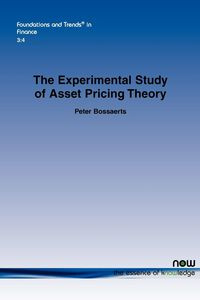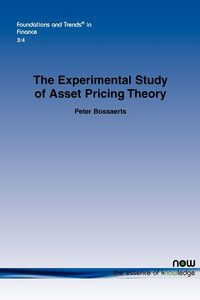The Experimental Study of Asset Pricing Theory - Peter Bossaerts
The Experimental Study of Asset Pricing Theory - Peter Bossaerts
EAN: 9781601982926
Marka
Symbol
887ESY03527KS
Autorzy
Peter Bossaerts
Rok wydania
2009
Elementy
90
Oprawa
Miekka
Format
15.6x23.4cm
Język
angielski

Bez ryzyka
14 dni na łatwy zwrot

Szeroki asortyment
ponad milion pozycji

Niskie ceny i rabaty
nawet do 50% każdego dnia
Niepotwierdzona zakupem
Ocena: /5
Marka
Symbol
887ESY03527KS
Kod producenta
9781601982926
Autorzy
Peter Bossaerts
Rok wydania
2009
Elementy
90
Oprawa
Miekka
Format
15.6x23.4cm
Język
angielski

The Experimental Study of Asset Pricing Theory is the first review of experimentation in asset pricing, which is both rare and novel. The goal of experimentation is twofold. First, experimentation is meant to evaluate the science behind asset pricing theory. Second, the goal of experimentation is to come to a deeper understanding of asset pricing theory.
The Experimental Study of Asset Pricing Theory sets the stage by first examining a sample data set that looks very much like the typical data set finance scholars gather from the field, only it was actually generated in the laboratory. The monograph then moves on to discuss risk aversion, since asset pricing theory builds on risk aversion. The issue is - is there enough risk aversion in the laboratory given typical levels of compensation? Asset pricing theory also builds on competitive equilibrium, but competitive equilibrium is an abstract notion; how can we get to it in the laboratory? The author builds on the path-breaking work of Vernon Smith and Charles Plott who demonstrated that certain trading institutions indeed allow us to generate competitive equilibrium. The author then presents the main findings - first concerning simple static asset pricing models, moving on to dynamic pricing theory, and the implications of ambiguity aversion. Asset pricing theory rarely discusses how markets reach equilibrium, but experiments shed new light on price behavior during equilibration, as well as on off-equilibrium allocation dynamics. The monograph also examines information aggregation and markets for loan and insurance contracts, where adverse selection may preclude equilibration, and even when not, the resulting allocations may be Pareto sub-optimal.
EAN: 9781601982926
EAN: 9781601982926
Niepotwierdzona zakupem
Ocena: /5
Zapytaj o produkt
Niepotwierdzona zakupem
Ocena: /5
Napisz swoją opinię

